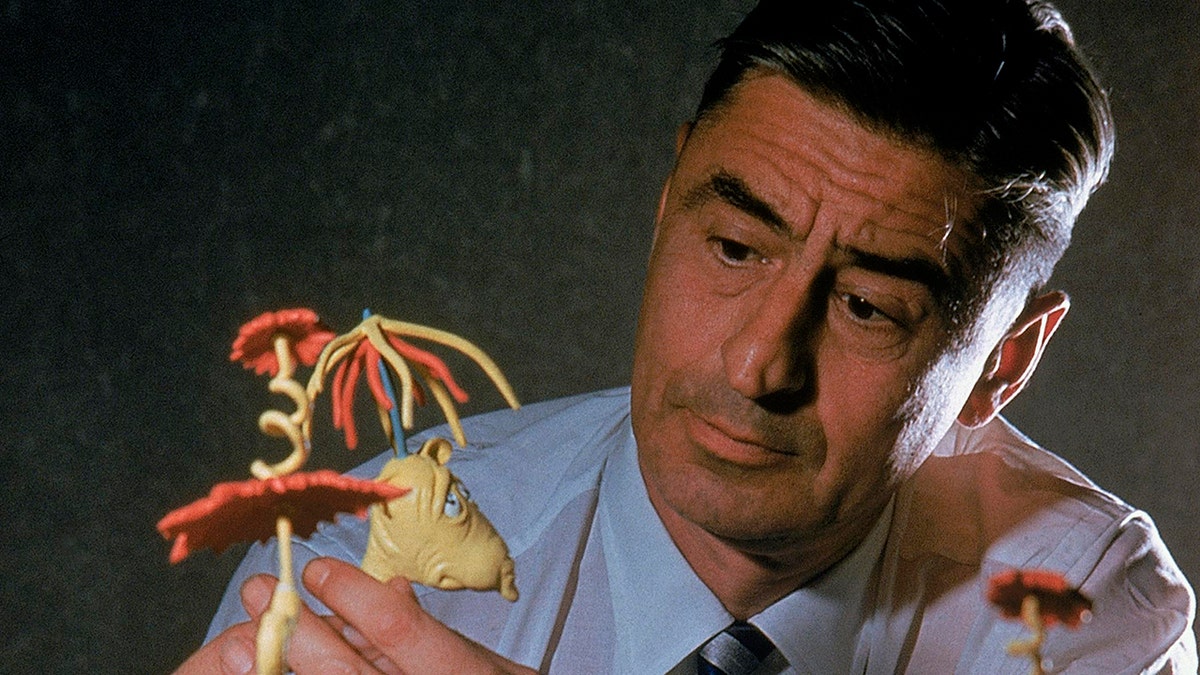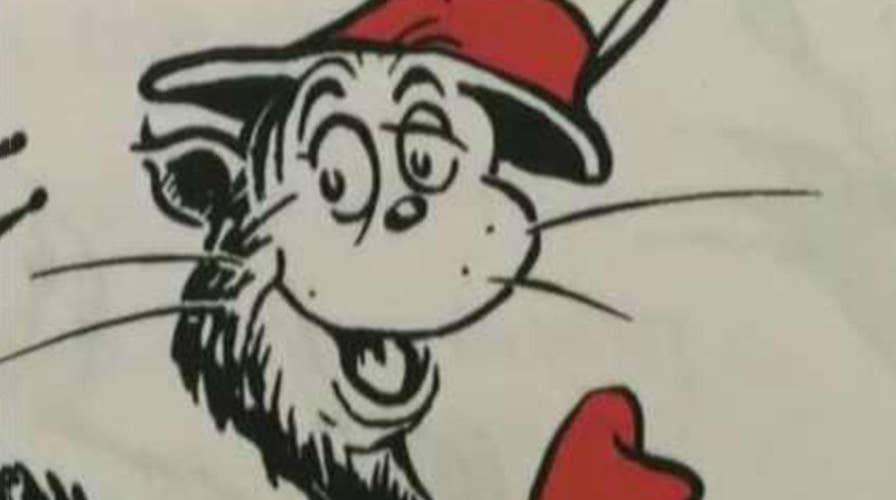Are Dr. Seuss books racist, anti-women?
Study finds many beloved books are 'problematic'; reaction from Mark Steyn on 'Tucker Carlson Tonight.'
Tuesday, March 2, marks National Read Across America Day, which also coincides with famous children’s author Dr. Seuss’ birthday.
The mind behind such beloved children’s characters as The Cat in the Hat, The Grinch and The Lorax was commemorated by the National Education Association by making his birthday synonymous with his life’s work – getting kids into reading through sheer entertainment.
However, 2021 marks a somewhat historic year for the legacy of the acclaimed author, whose real name was Theodore Seuss Geisel. As schools across America highlight the value of literacy, Dr. Seuss Enterprises, the business tasked with preserving and protecting the author’s legacy, announced that six of his early works will no longer be published due to "hurtful and wrong" depictions of other races.
As the works of Dr. Seuss are recontextualized for a modern era, it’s worth taking a look back at who the enigmatic children’s author was, and how he got his start and became the beloved and wacky mind behind some of the most famous stories from Americans' childhoods.
Early life
Geisel was born on March 2, 1904, to parents Henrietta Seuss Geisel and Theodore R. Geisel. His youth was spent routinely visiting the local zoo, where he developed an affinity for animals that he would carry into his work, which was marked by both real and fantastical imaginary beasts.
According to his obituary in the New York Times, he said that he "used to hang around there a lot" and would even get into the cages with small lions and tigers.
VIRGINIA SCHOOL SYSTEM CANCELS DR. SEUSS, CITING RACIAL 'UNDERTONES' IN WRITINGS: REPORT
"I got chewed up every once in a while," he once said.

Portrait of author and illustrator Theodor Geisel (1904 - 1991), better known as Dr Seuss, New York, New York, April 4, 1957. (Al Ravenna/PhotoQuest/Getty Images)
He went on to study English at Dartmouth, where he graduated in 1925. While there, he developed his writing and humor skills, often illustrating cartoons and writing comedy pieces for the school’s humor magazine, where he eventually became the editor-in-chief.
Geisel becomes Seuss
According to The Washington Post, the popular pen name behind his famous children's works came about in a somewhat adult way.
As a senior at Dartmouth, he and his friends were busted by the local police chief for drinking a pint of bootleg gin inside his dorm room. Given that alcohol of any kind was illegal during Prohibition, when the bust took place, Geisel faced some serious consequences. Most notably, he was forced to quit extracurricular activities, including being editor of the humor magazine. However, cartoons inked in his style continued to show up in the magazine under several pen names, including "Seuss."
He would later add the "Dr." to his name after leaving Dartmouth despite never finishing his doctorate at Oxford. Instead, the woman who would become his first wife recognized his talent for humor and artwork and encouraged him to veer in that direction rather than the professorial path he was on.
"Ted's notebooks were always filled with these fabulous animals," his first wife, Helen Palmer, once said (via the New York Times). "So I set to work diverting him; here was a man who could draw such pictures; he should be earning a living doing that."
Getting started
Because of his raw talent, the author didn’t have too much trouble making money off his cartoons and writing. He moved to New York City shortly after leaving Oxford and marrying his wife. There, he published material for Vanity Fair, Liberty and had a regular job at Judge. However, it was getting tapped for an advertising campaign with the company "Flit" that gave him some name recognition.

1959: Author/illustrator Theodor Seuss Geisel posing w. models of characters he has created. (John Bryson/The LIFE Images Collection via Getty Images/Getty Images)
He would go on to write popular ads for other companies like Holly Sugar, NBC, Ford and General Electric, according to Insider.
He published his first children’s book thanks to a chance encounter with an old Dartmouth classmate. After his story "And to Think that I Saw It on Mulberry Street," which is among the six that will no longer be published, was rejected more than 20 times, he was about to call it quits when he bumped into a pal on a New York City street. The conversation led to the book being published and kicking off his career as a kids’ writer.
"If I had been going down the other side of Madison Avenue, I’d be in the dry-cleaning business today," he later said, according to History.com.
The war
When WWII broke out, Geisel applied his talents to the military. He took a break from humor and began doing political cartoons for a New York newspaper. According to a 1999 book written by Richard H. Minear, the author took particular exception with non-interventionists, or "isolationists," such as Charles Lindbergh, who opposed U.S. entry into the conflict. Other cartoons were largely critical of Republicans and Adolf Hitler.
He joined the Army as a captain and was commander of the Animation Department of the First Motion Picture Unit of the U.S. Army Air Forces. His job was primarily to write films for propaganda purposes as well as to help train soldiers.
One of the films he made at that time, "Design for Death," went on to win him his first of two Academy Awards. He would take home another in 1951 for "Gerald McBoing-Boing," an animated film, according to Insider. The outlet notes that he also won two Emmy Awards before his death as well.
Back to normal
Shortly after the war, Geisel moved to California and went back to children’s books, penning some of his most memorable such as "If I Ran the Zoo," "Horton Hears a Who!" "If I Ran the Circus," "How the Grinch Stole Christmas!" "Green Eggs and Ham" and many more.
CLICK HERE TO SIGN UP FOR OUR ENTERTAINMENT NEWSLETTER
According to a report from The New Yorker in 2002, the literary community was worried about the lack of literacy among America’s youth in the late 1950s. Geisel took it upon himself to take a list of words that most first graders should recognize and put them into a story that the youth would find both educational and impossible to put down.

American author and illustrator Dr Seuss (Theodor Seuss Geisel, 1904 - 1991) sits at his drafting table in his home office with a copy of his book, 'The Cat in the Hat', La Jolla, California, April 25, 1957. (Gene Lester/Getty Images)
In 1957, "The Cat in the Hat" was published, cementing the author’s place in cultural and literary history forever.
Legacy
Geisel died in 1991 with a bevy of more than 60 published works behind him. However, he’s far from forgotten.
The author remains popular, earning an estimated $33 million before taxes in 2020, up from just $9.5 million five years ago, the company said. Forbes listed him No. 2 on its highest-paid dead celebrities of 2020, behind only the late pop star Michael Jackson.
CLICK HERE TO GET THE FOX NEWS APP
The National Education Association, which founded Read Across America Day in 1998 and deliberately aligned it with Geisel’s birthday, has for several years deemphasized Seuss and encouraged a more diverse reading list for children.
As adored as Dr. Seuss is by millions around the world for the positive values in many of his works, including environmentalism and tolerance, there has been increasing criticism in recent years over the way Black, Asian and other characters are drawn in some of his most beloved children’s books, as well as in his earlier advertising and propaganda illustrations.







